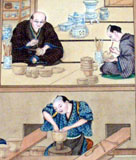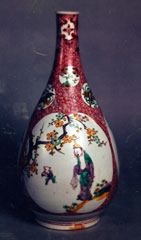| Japanese
Ceramics in the Ashmolean |

A potter's workshop attributed to Kawahara Keiga
|
| The
part of the collection of Japanese ceramics for which the Ashmolean is best
known is the collection of Export porcelain, covering the period from the
beginning of the trade with the Dutch in the 1650s to the end of that trade
in about 1740. This collection, now published (Impey, 2002) is one of the
most extensive in the west.
|
|
| Prehistory
(before about 500 AD) and the early historical periods |
- A small selection of middle Jomon pots, vigorously
modelled in apparently abstract designs, and decorated with rope-twist
(jomon) patterns is supported by a small collection of provenanced potsherds.
The great earthenware grave-sculptures, Haniwa are represented by a
caparisoned horse's head, and by a figure of a goose; these, formed
on the basis of tubes of clay, stood outside the key-hole shaped tombs
of the early historic period.
-
|
|
